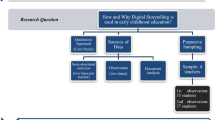Abstract
Objective
In the interest of finding “teaching moments in film” for psychiatric education and education on child development, the author describes an approach to analyzing Disney—and potentially other children’s films—based on specifically observing family structure at the beginning and ending of the story, developmental stage and gender of the protagonist, the developmental crisis, and the external change agent and/or stressor.
Methods
The author considered a convenience sample of ten popular Disney films.
Results
A wide variety of family structures and developmental stages and challenges were observed in the reviewed films.
Conclusions
A matrix approach such as the one illustrated may help psychiatric educators to select effective teaching moments from Disney and other children’s films.
Similar content being viewed by others
References
Akram A, O’Brien A, O’Neill A, Latham R. Crossing the line—learning psychiatry at the movies. Int Rev Psychiatr. 2009;21:267–8.
Sierles FS. Using film as the basis of an American culture course for first-year psychiatry residents. Acad Psychiatr. 2005;29:100–4.
Zerby SA. Using the science fiction film Invaders From Mars in a child psychiatry seminar. Acad Psychiatr. 2005;29:316–21.
Tanner LR, Haddock SA, Zimmerman TS, Lund LK. Images of couples and families in Disney feature-length animated films. Am J Fam Ther. 2003;31:355–73.
Dan B, Christiaens F. Dopey’s seizure. Seizure. 1999;8:238–40.
Janković SM, Sokić DV, Vojvodić NM, Ristić AJ. The first film presentation of REM sleep behavior disorder precedes its scientific debut by 35 years. Srp Arh Celok Lek. 2006;134:466–9.
Beveridge A. Images of madness in the films of Walt Disney. Psychiatr Bull. 1996;20:618–20.
Lawson A, Fouts G. Mental illness in Disney animated films. Can J Psychiatry. 2004;49:310–4.
Baker-Sperry L, Grauerholz L. The pervasiveness and persistence of the feminine beauty ideal in children’s fairy tales. Gend Soc. 2003;17:711–26.
Baker-Sperry L. The production of meaning through peer interaction: children and Walt Disney’s Cinderella. Sex Roles. 2007;56:717–27.
Lacroix C. Images of animated others: the orientalization of Disney’s cartoon heroines from The Little Mermaid to The Hunchback of Notre Dame. Pop Commun. 2004;2:213–29.
Hurley DL. Children of color and the Disney fairy tale princess. J Negro Educ. 2005;74:221–32.
Fouts G, Callan M, Piasentin K, Lawson A. Demonizing in children’s television cartoons and Disney animated films. Child Psychiatry Hum Dev. 2006;37:15–23.
Goldstein AO, Sobel RA, Newman GR. Tobacco and alcohol use in G-rated children’s animated films. JAMA. 1999;281:1131–6.
Kirsh SJ. Cartoon violence and aggression in youth. Aggress Violent Behav. 2006;11:547–57.
Bettelheim B. The uses of enchantment: the meaning and importance of fairy tales. New York: Random House LLC; 2010.
Disclosures
The author states that there is no conflict of interest.
Author information
Authors and Affiliations
Corresponding author
Rights and permissions
About this article
Cite this article
Guerrero, A.P.S. An Approach to Finding Teaching Moments on Families and Child Development in Disney Films. Acad Psychiatry 39, 225–230 (2015). https://doi.org/10.1007/s40596-014-0240-6
Received:
Accepted:
Published:
Issue Date:
DOI: https://doi.org/10.1007/s40596-014-0240-6




